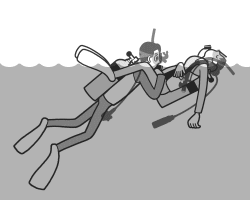 Dealing With Emergencies 3 Dealing With Emergencies 3
|
|
■Emergency Ascent
When there is no other option but to swim to the surface, while ascending you must constantly blow small bubbles to avoid a lung over-expansion injury. It is very important here to control your speed of ascent as much as possible. |

Ascend while blowing small bubbles |
|
■Positive Ascent
Again, when there is no other option but to swim to the surface, and controlling speed of ascent is not a priority (such as a serious injury), you drop your weight belt and use any available BC/dry suit air to ascend. |

Drop your weight belt before ascending |
|
■Diver Tow
Pulling an injured or fatigued diver on the water’s surface is called a tow. It is possible to perform artificial respiration while towing a diver. |

BC Pull Method |

Fin Push Method |
|

